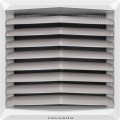Power consumption
The power consumed by the electrical components of the industrial heater during operation.
This parameter allows, first of all, to assess the load on the power grid and the suitability of the available power for the normal operation of the unit. It is relevant for all types of modern industrial heaters (see "Power supply"). However, it is worth noting that in some electric models, the power consumption is indicated for the ventilation mode. In this mode, the heating element is not activated, and the power consumption is extremely low — a few tens of watts. In such cases, the total power can be estimated from the maximum thermal output (see above) — in electrical models, these parameters practically do not differ from each other.
Protection class (IP)
An indicator that determines the degree of protection of dangerous (moving and current-carrying) parts of an industrial heater from adverse effects, namely solid objects and water. The level of protection is usually indicated by a marking of the letters IP ("ingress protection")) and two numbers, the first of which indicates protection against the effects of solid objects, and the second — against the ingress of water.
For the first digit, each value corresponds to the following protection values:
1 — protection against objects with a diameter of more than 50 mm (large body surfaces)
2 — from objects with a diameter of more than 12.5 mm (fingers, etc.)
3 — from objects larger than 2.5 mm (most instruments)
4 — from objects more than 1 mm (almost all tools, most wires)
5 — dustproof (full protection against contact; dust can penetrate inside, but does not affect the operation of the device)
6 — dust tight (case with full protection against dust and contact).
For the second digit:
0 — completely unsuitable for contact with water, the device requires protection from moisture and is not suitable for rooms with high humidity.
1 — protection against vertically falling drops of water
2 — from water drops with a deviation of up to 15 ° from the vertical axis of the device
3 — from water drops with a deviation of up to 60 ° from the vertical axis of the device (rain)
4 — against splashes from any...direction 5 — against jets from any direction
6 — from sea waves or strong water jets
7 — the possibility of short-term immersion to a depth of 1 m (without the possibility of continuous operation in immersed mode)
8 — the possibility of long-term immersion to a depth of more than 1 m (with the possibility of continuous operation in immersed mode).
The protection class of industrial heaters, usually, is quite low, because the very principle of operation of these devices involves an abundance of holes and openings.
Noise level
The maximum noise level produced by the industrial heater during normal operation. For comparison, 50 decibels roughly corresponds to the noise in an office room, 60 dB to an average TV volume, 70 dB to a truck at a distance of about 8 m, 80 dB to traffic noise, and 90 dB to a scream. The lower the noise level, the more comfortable the use of the unit, especially when placed close to people or in echoing rooms where the sound does not fade for a long time.

